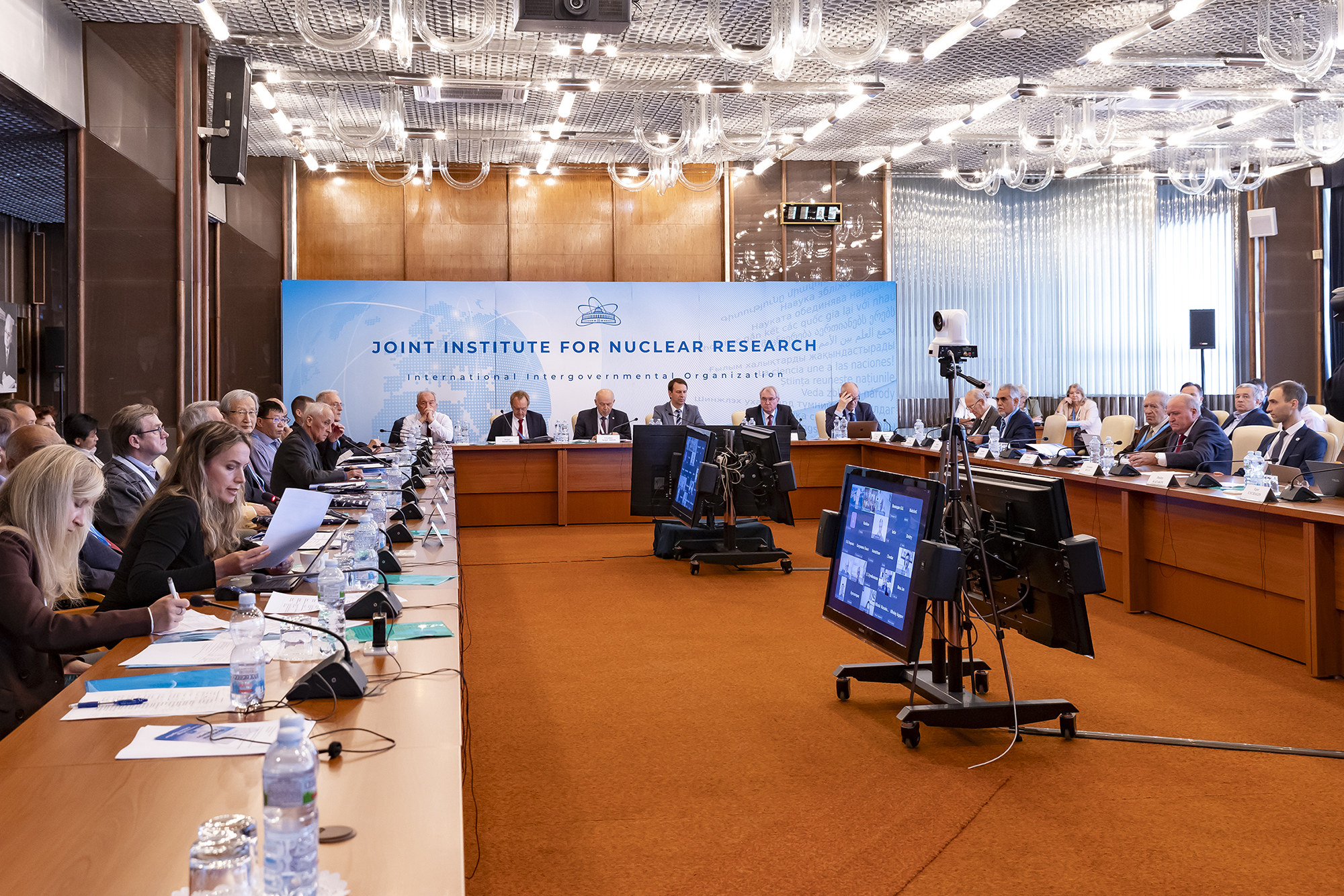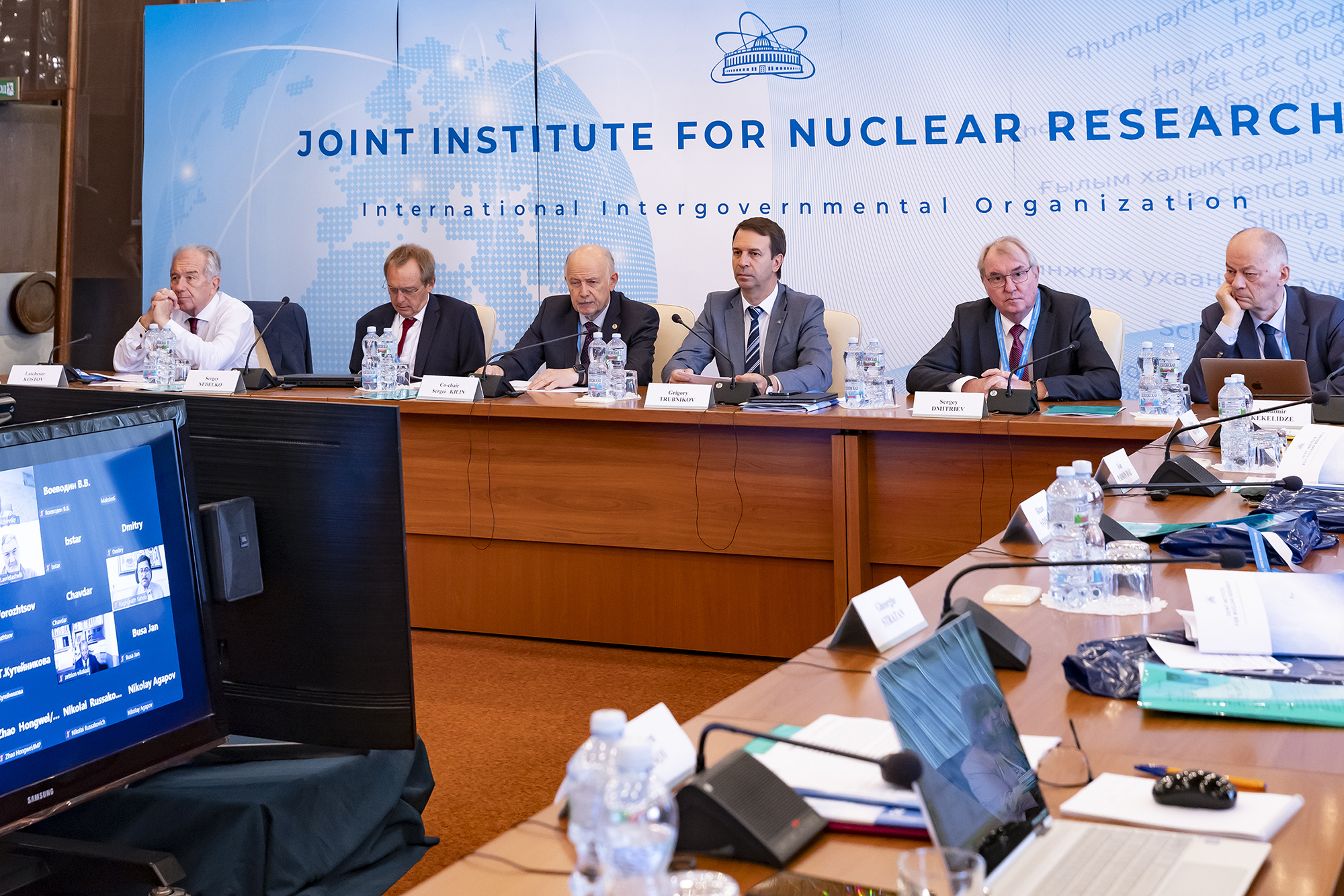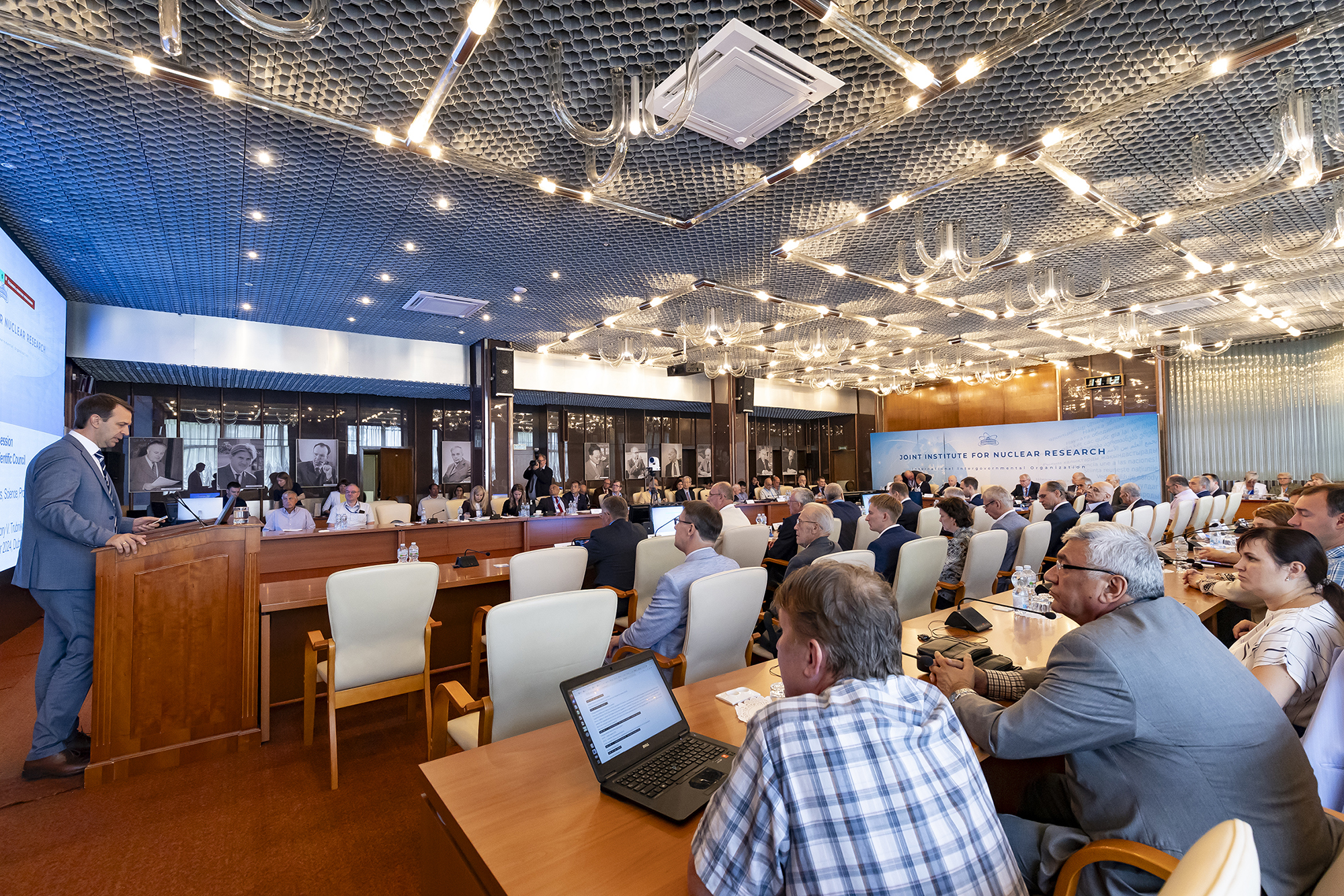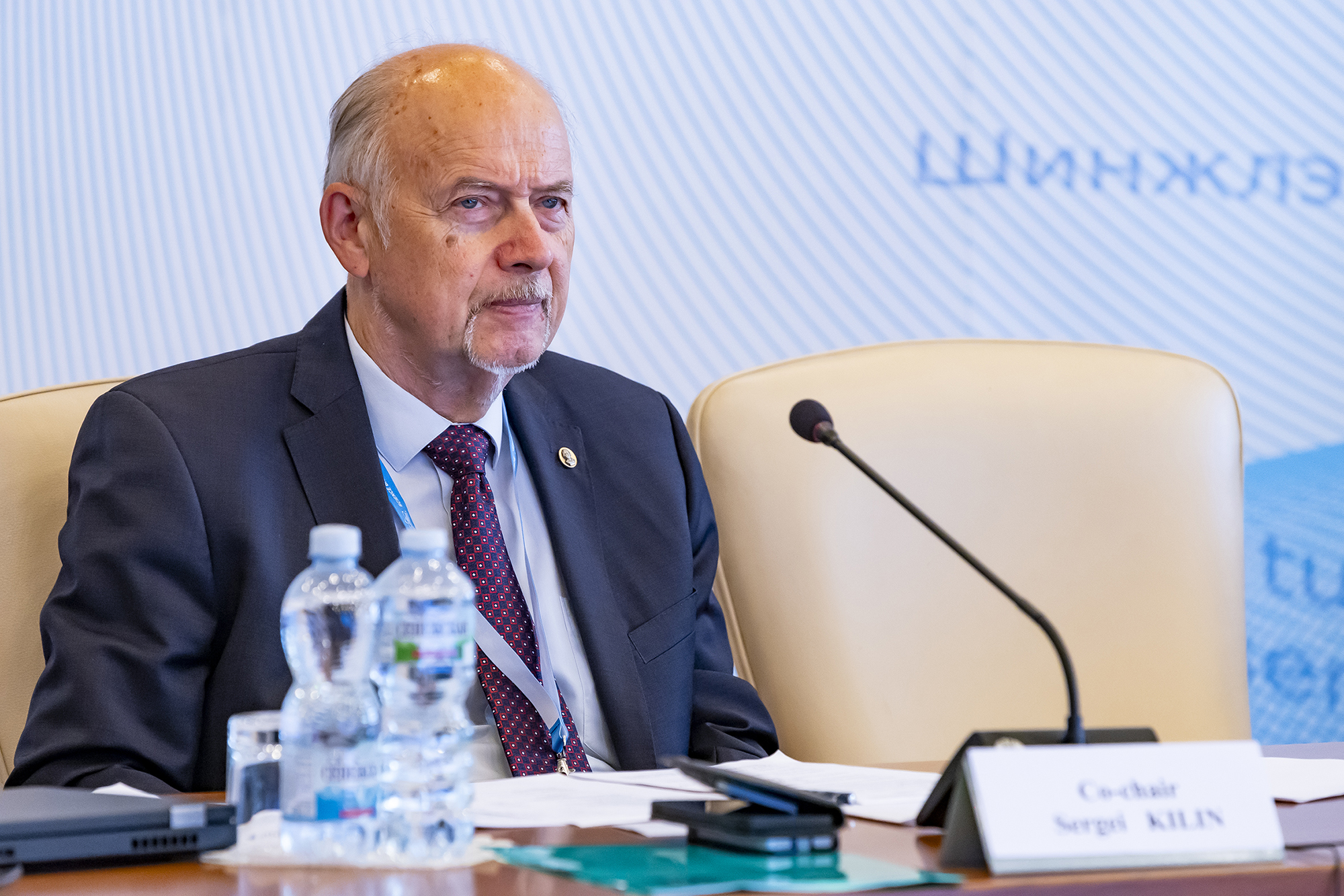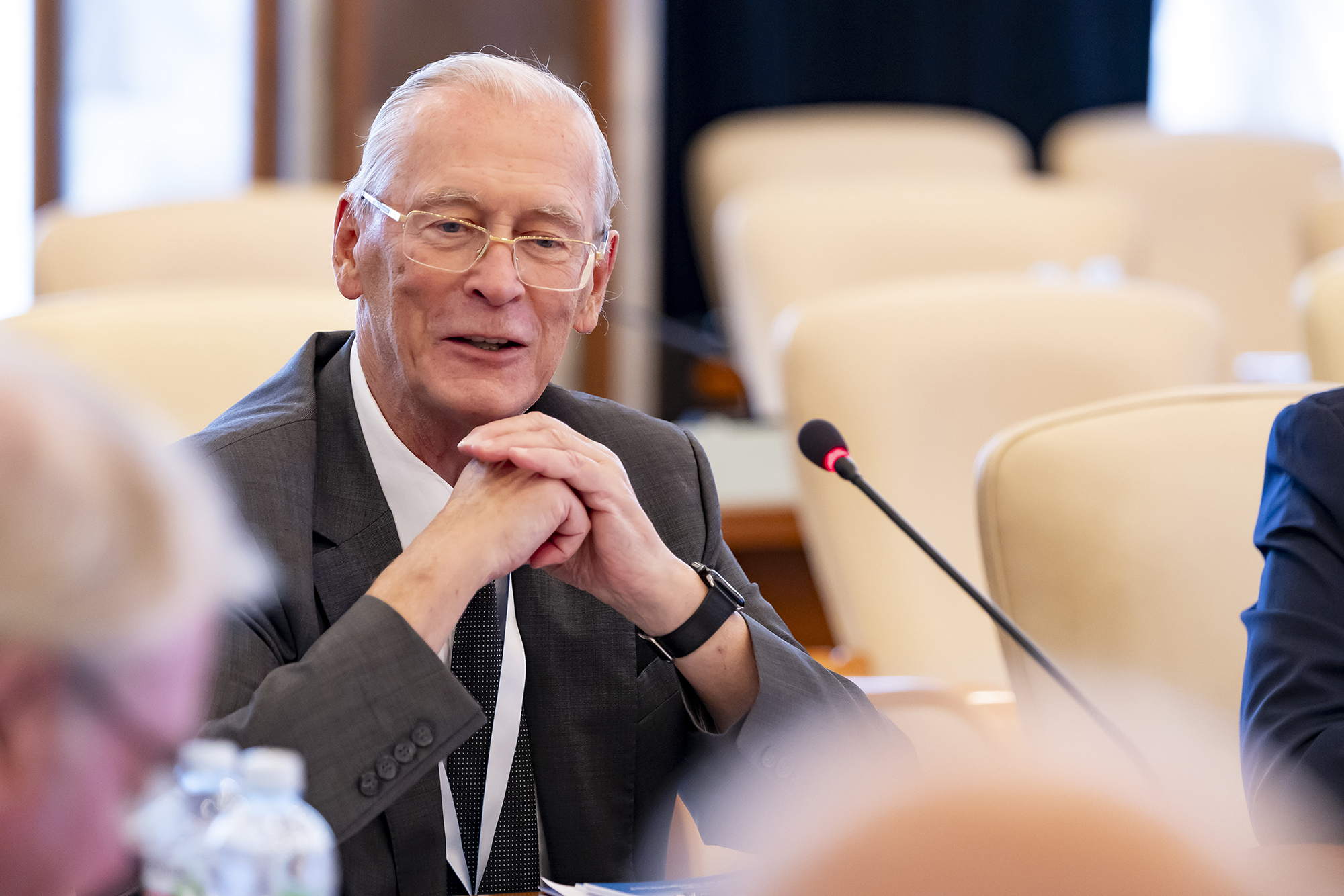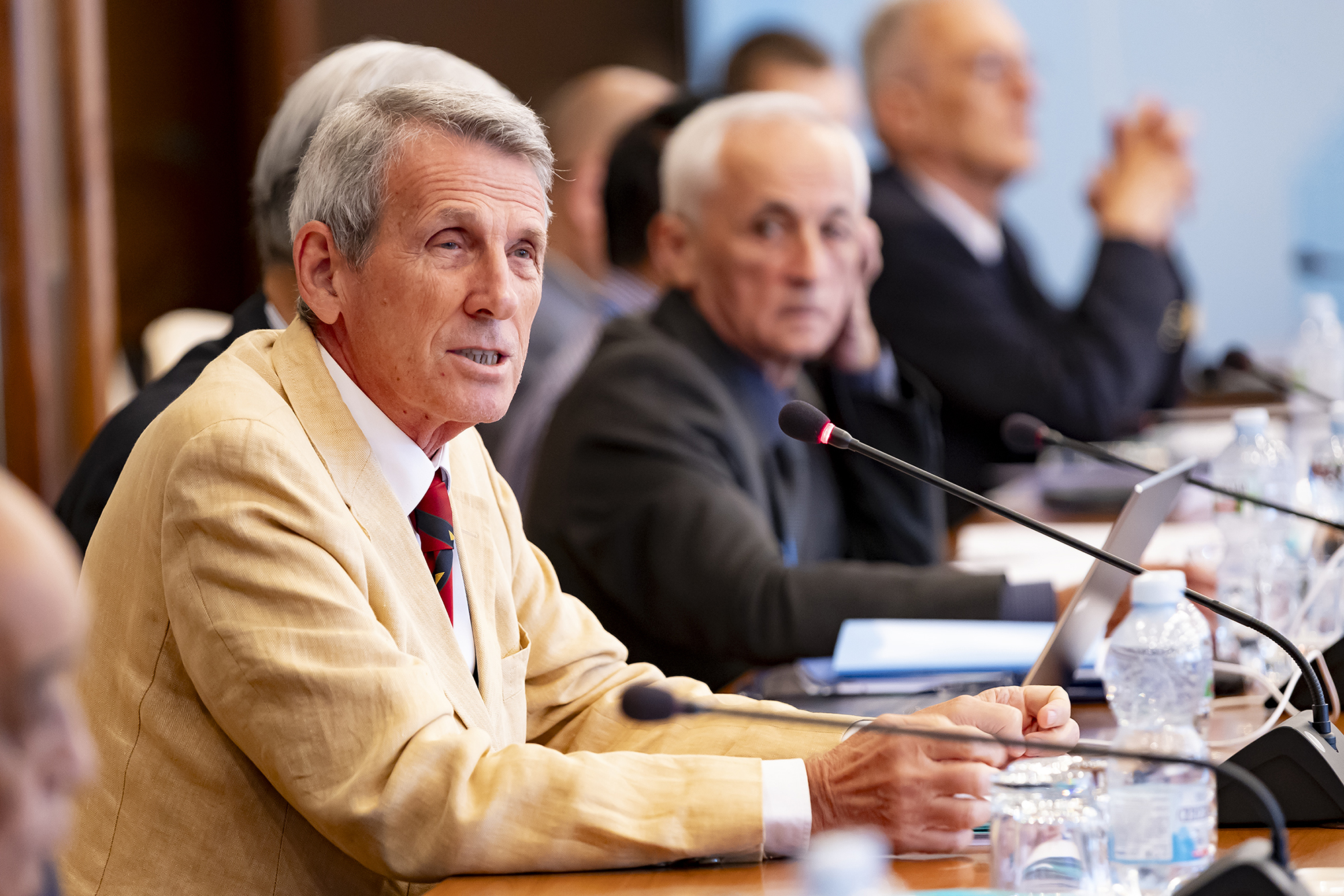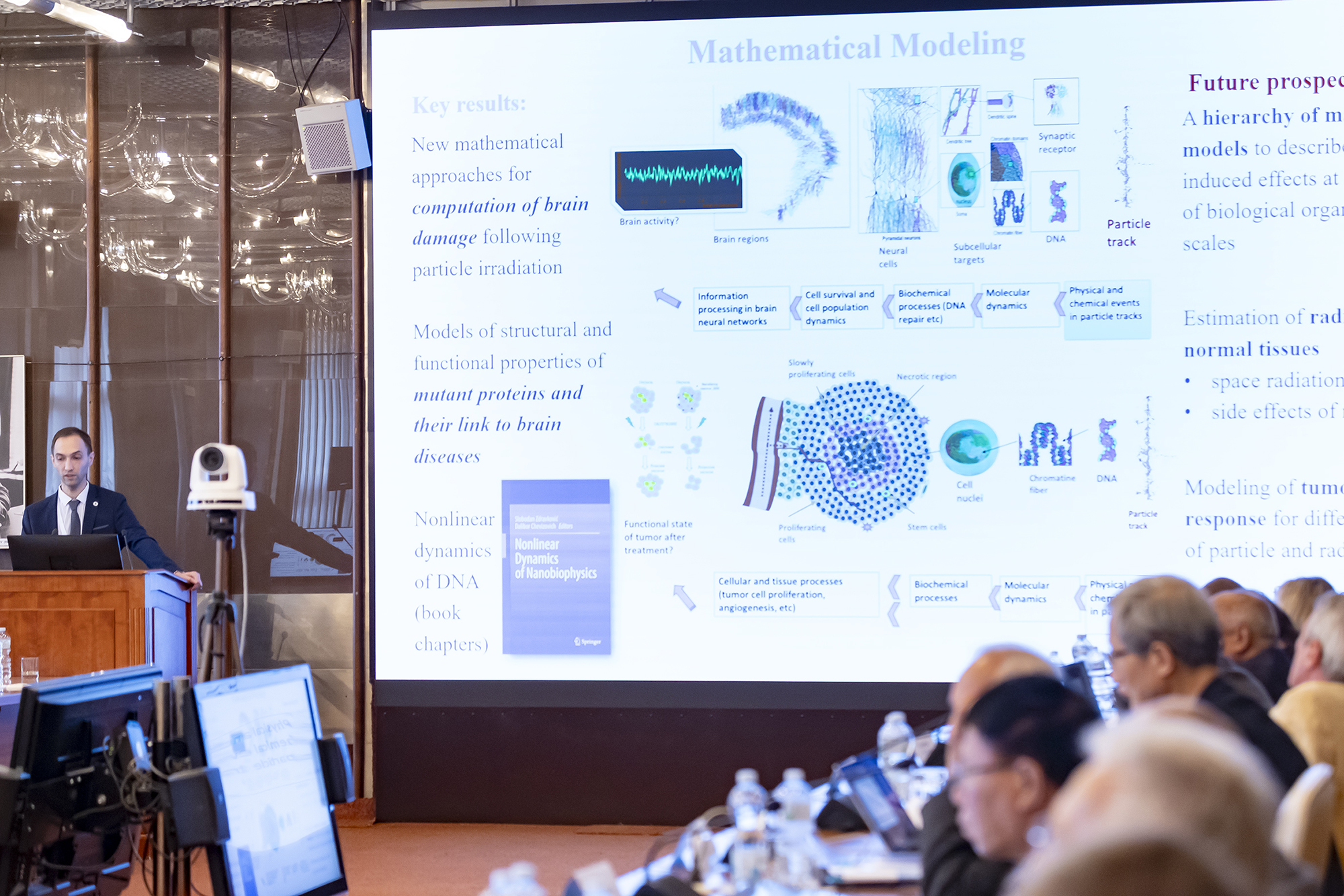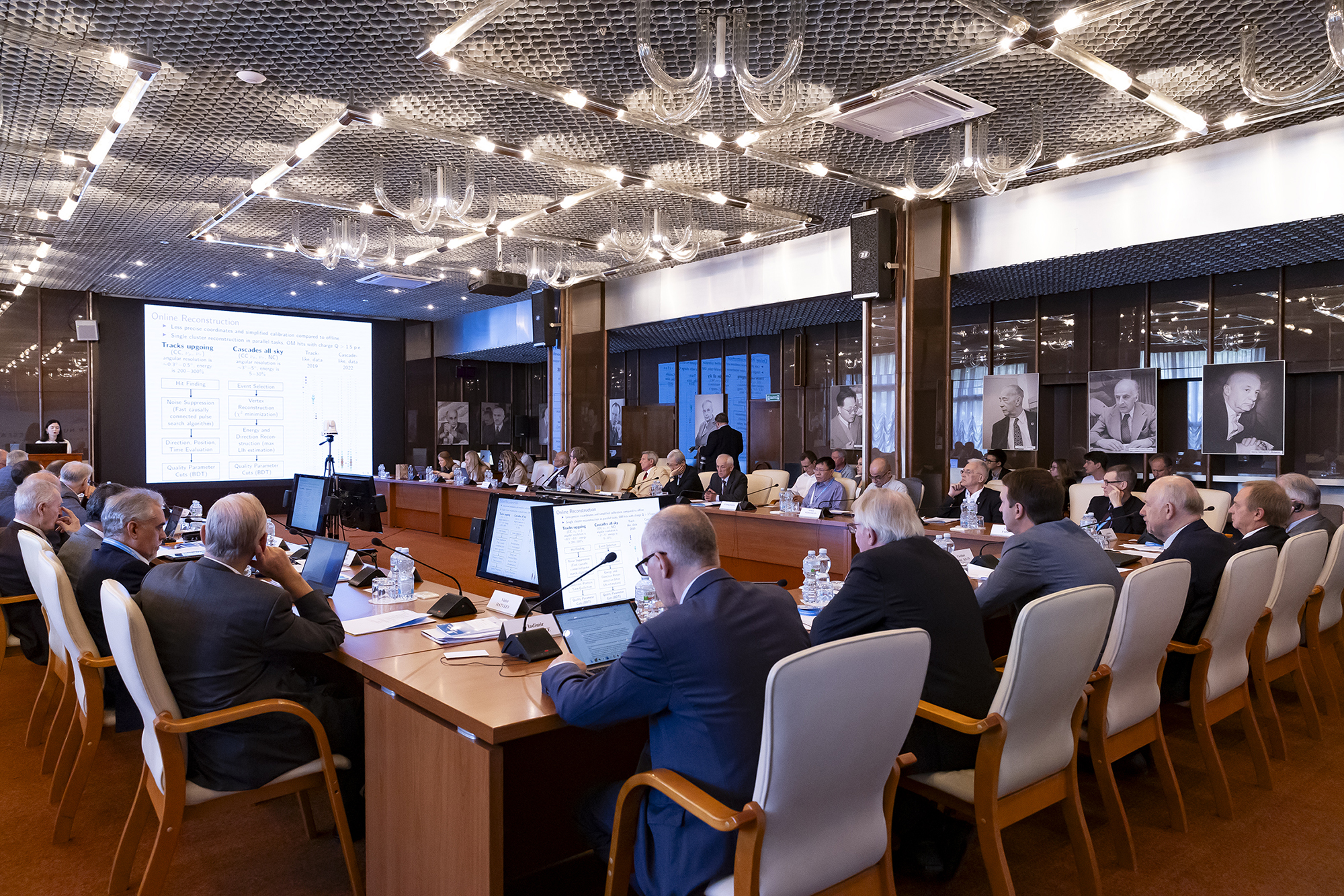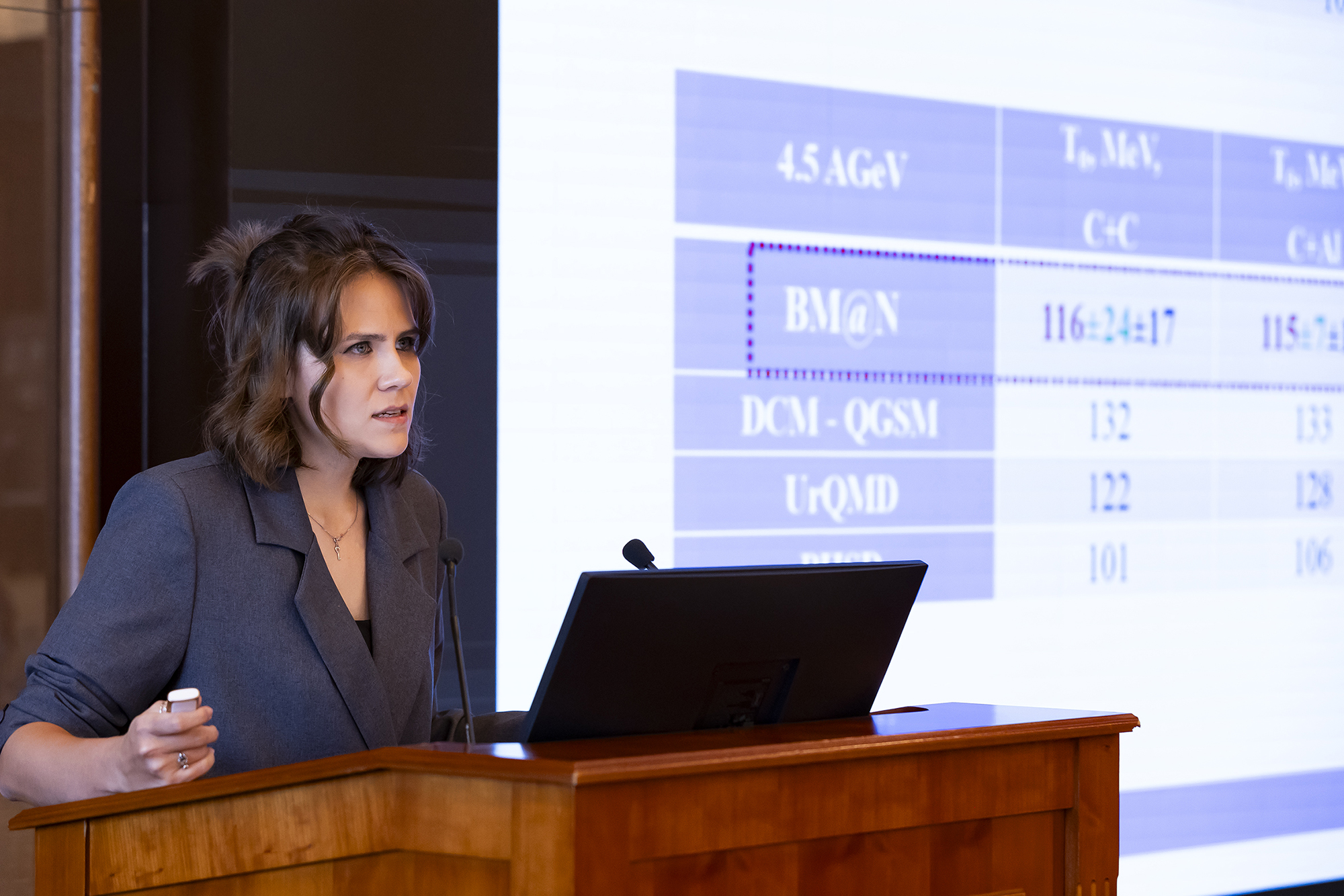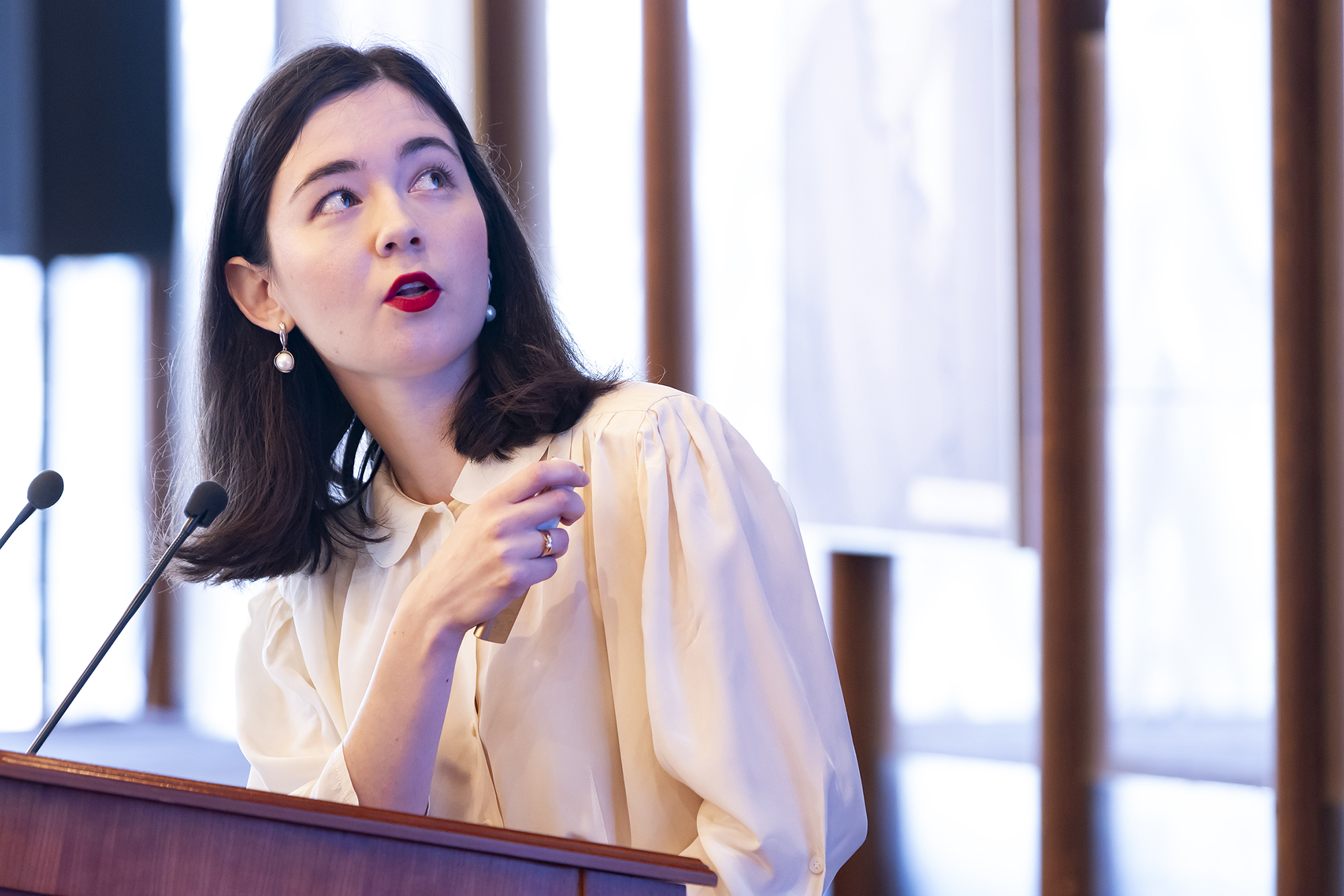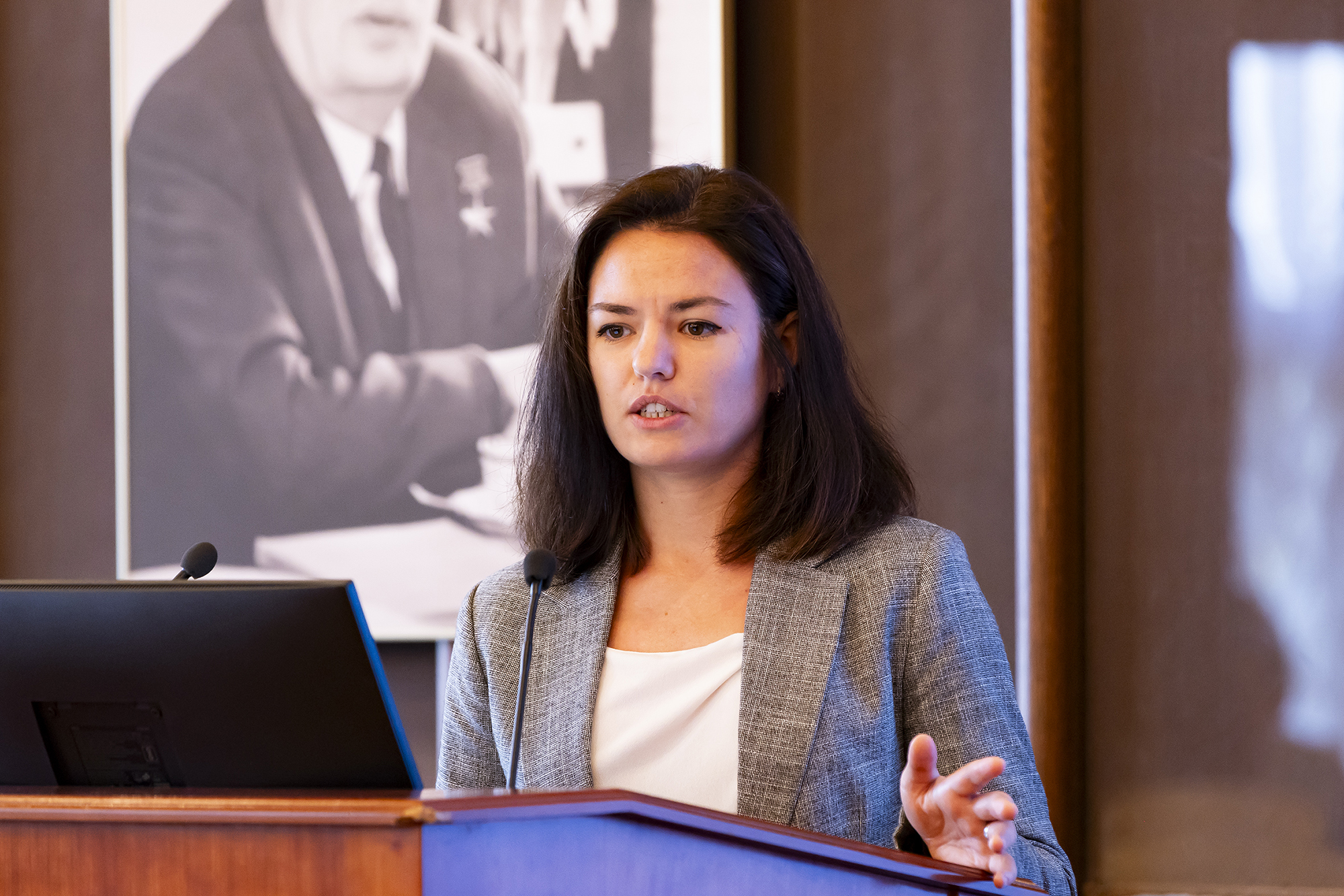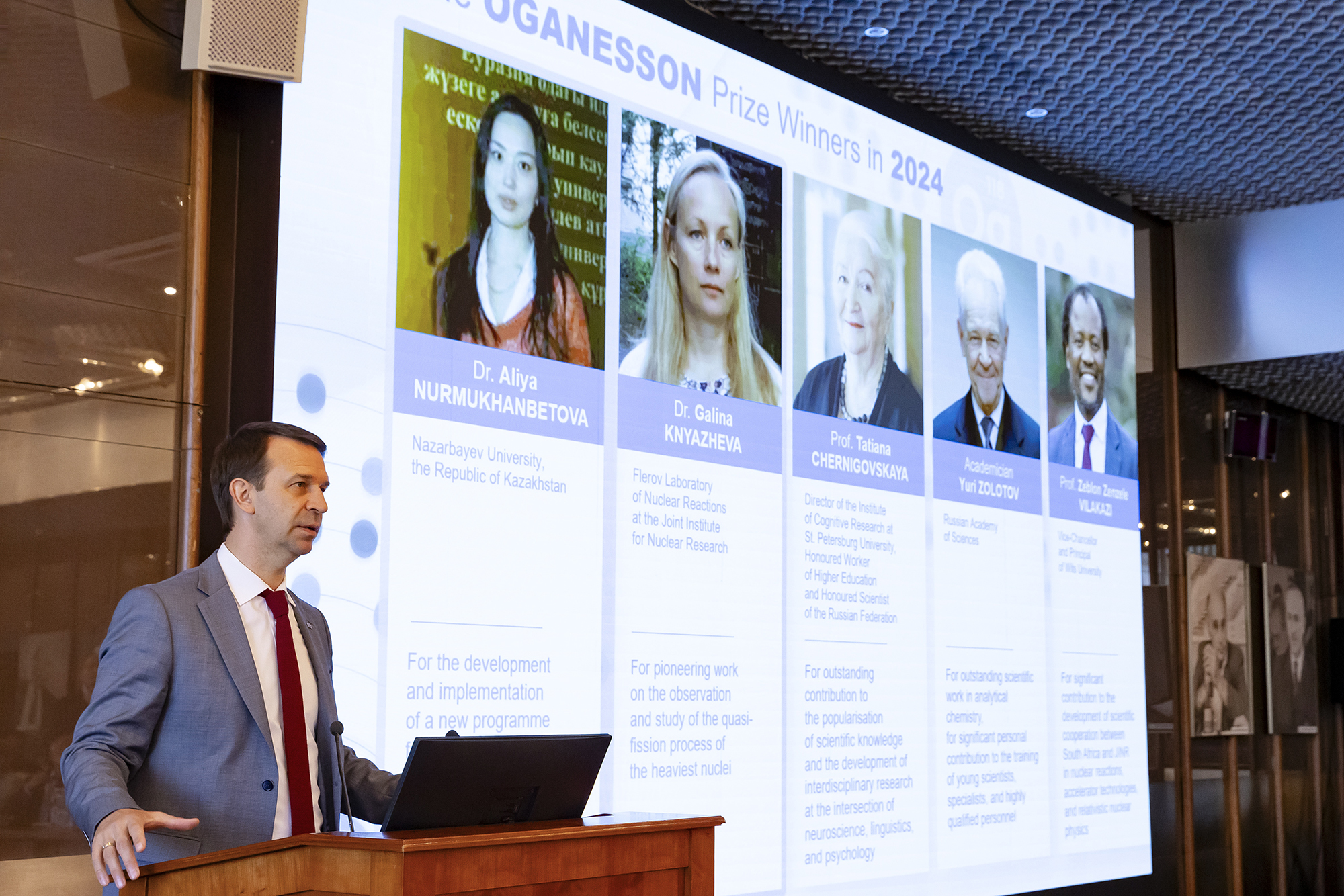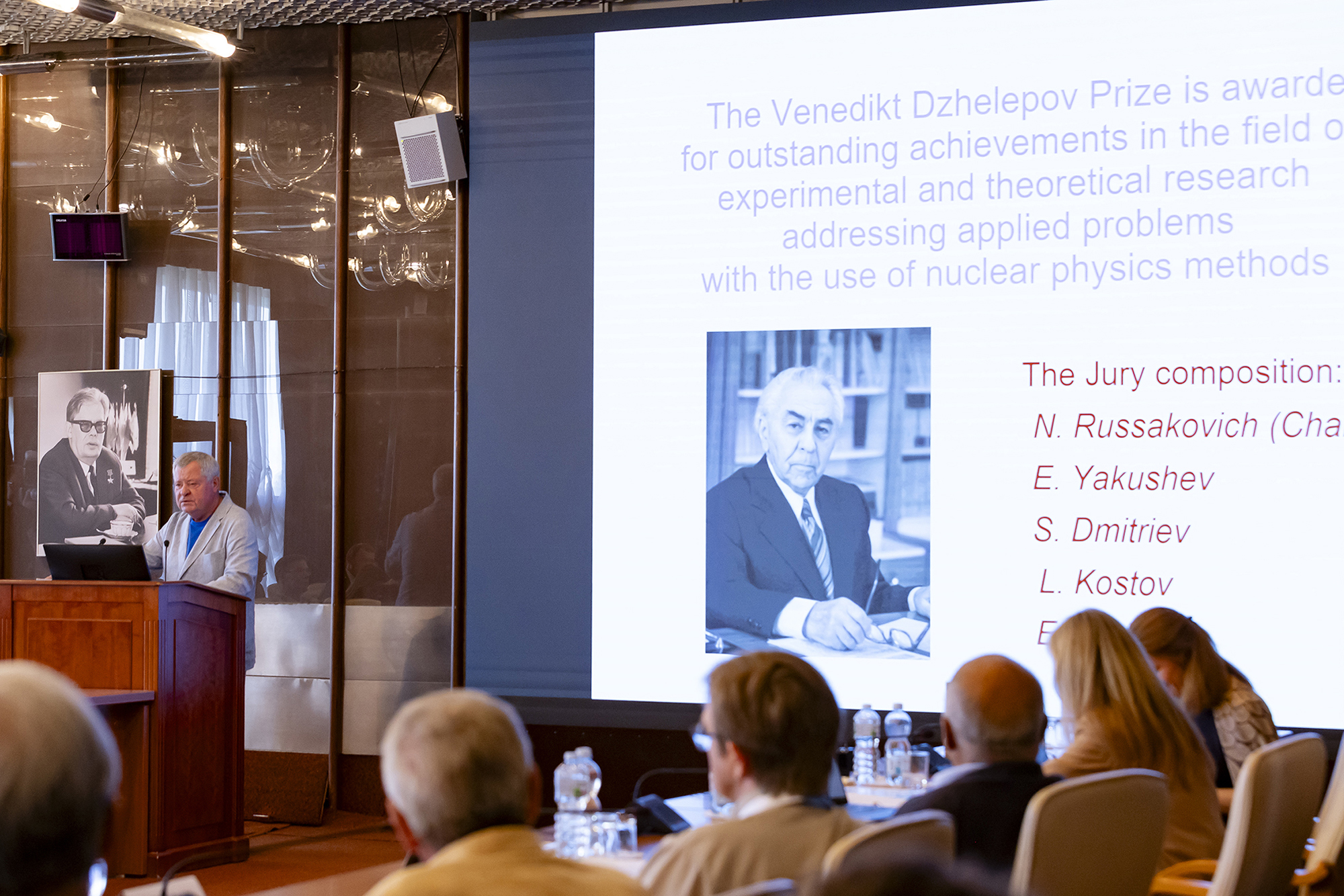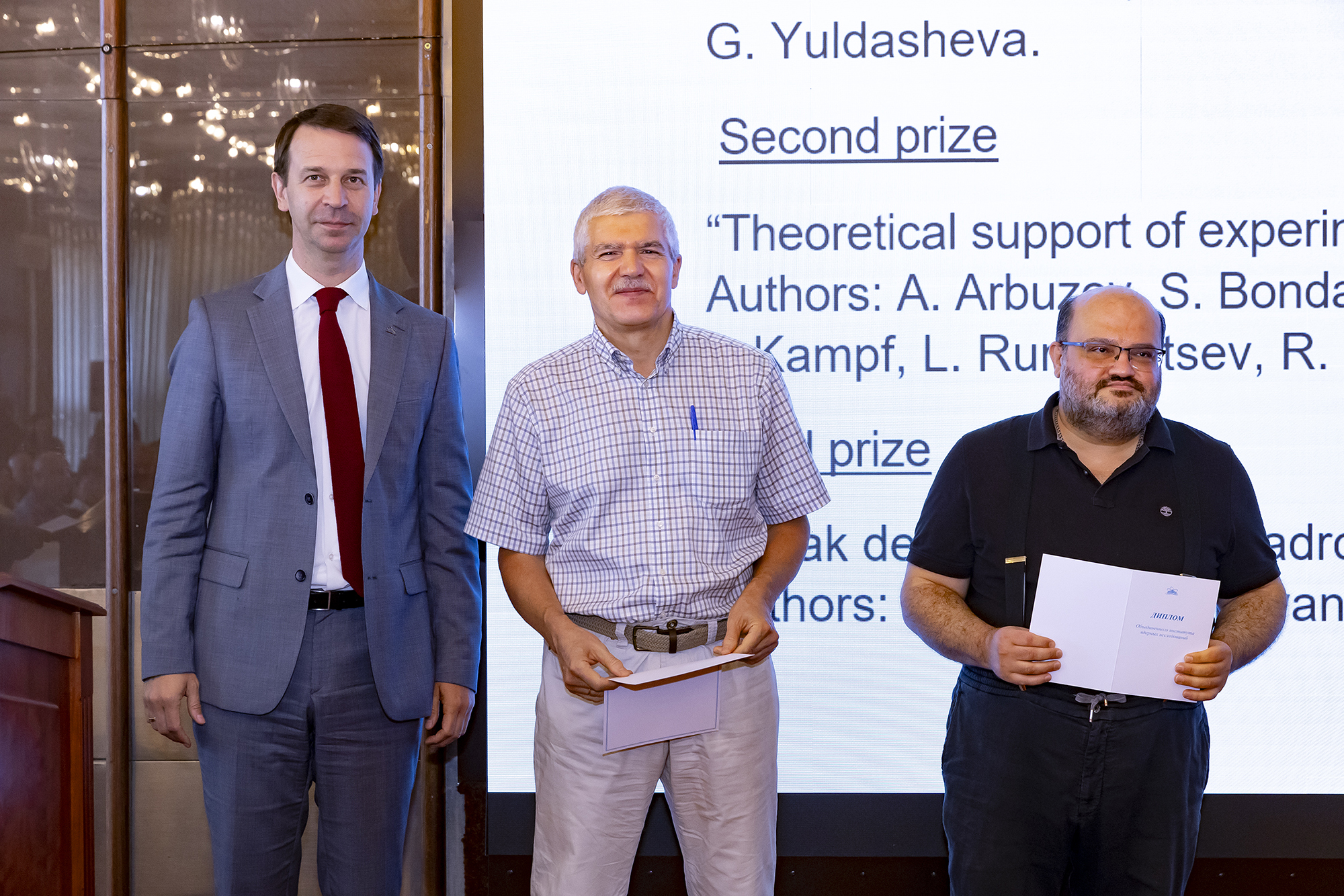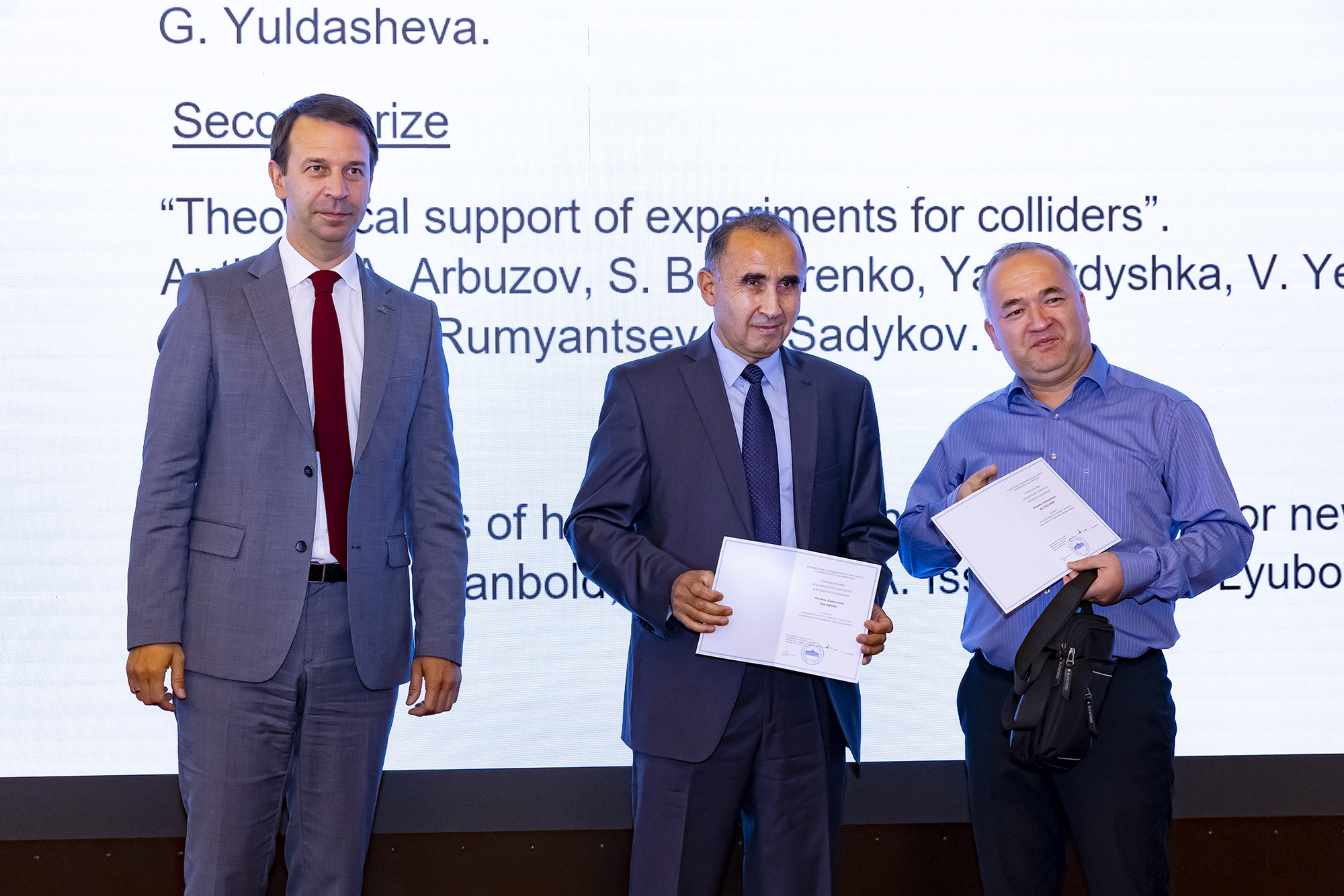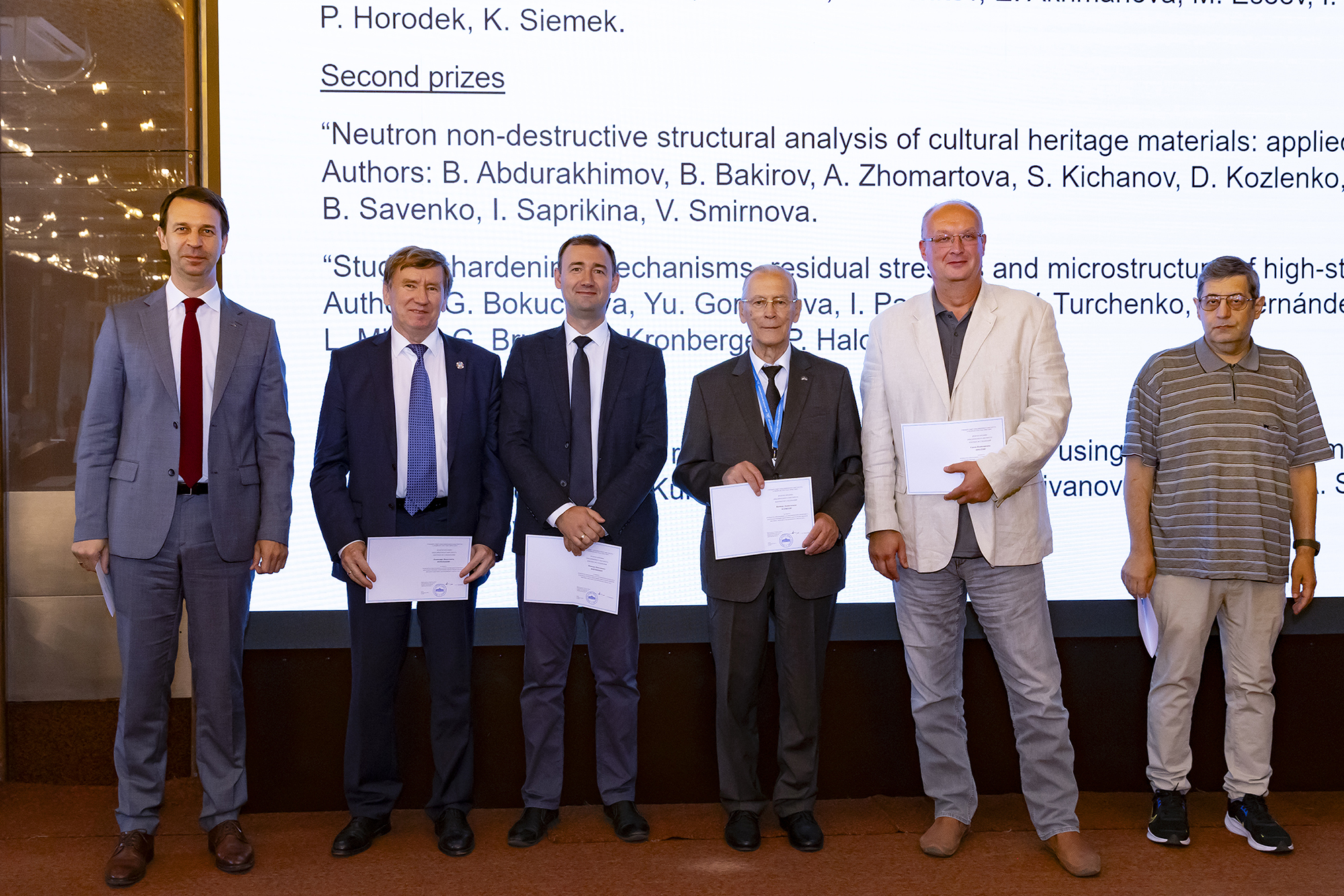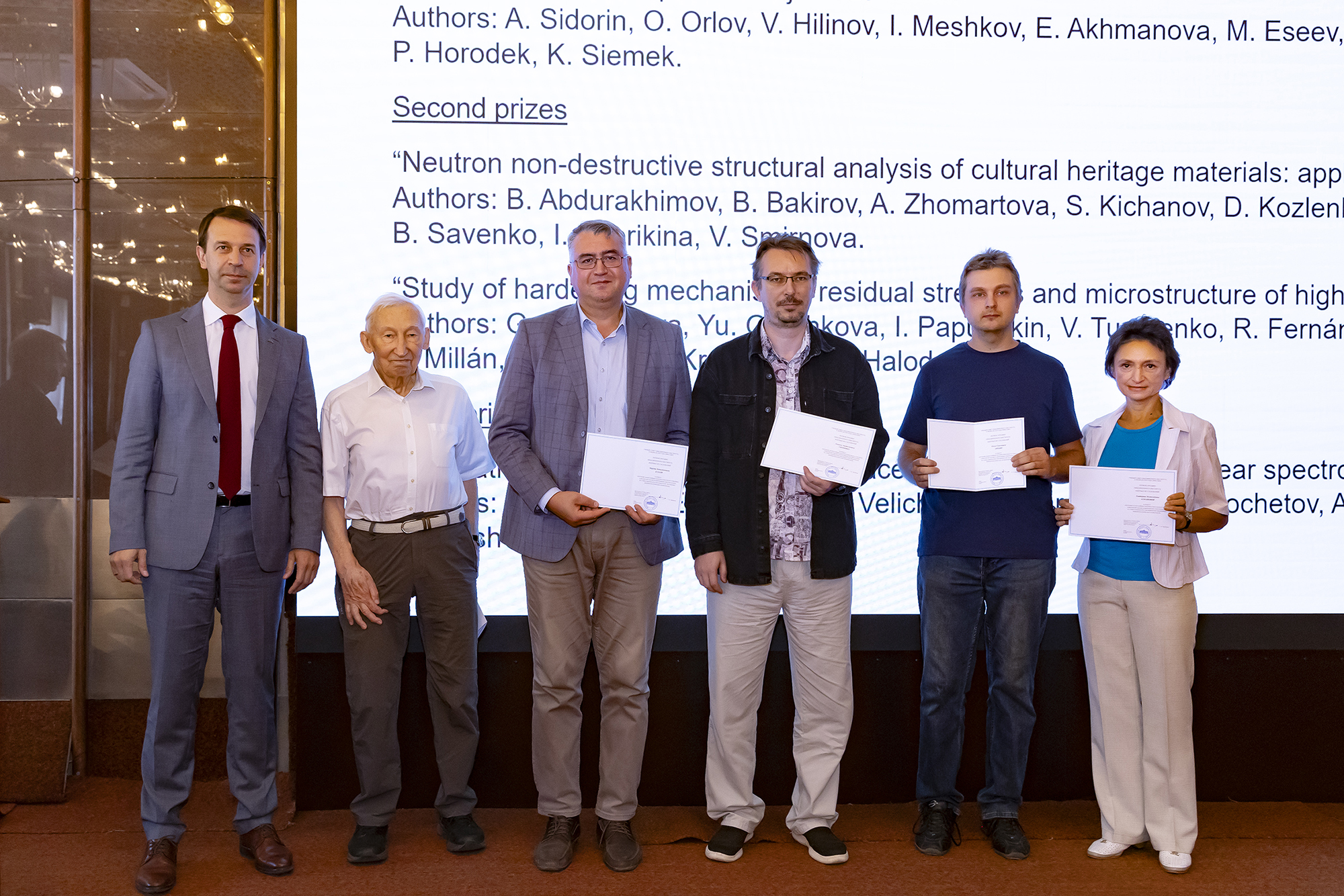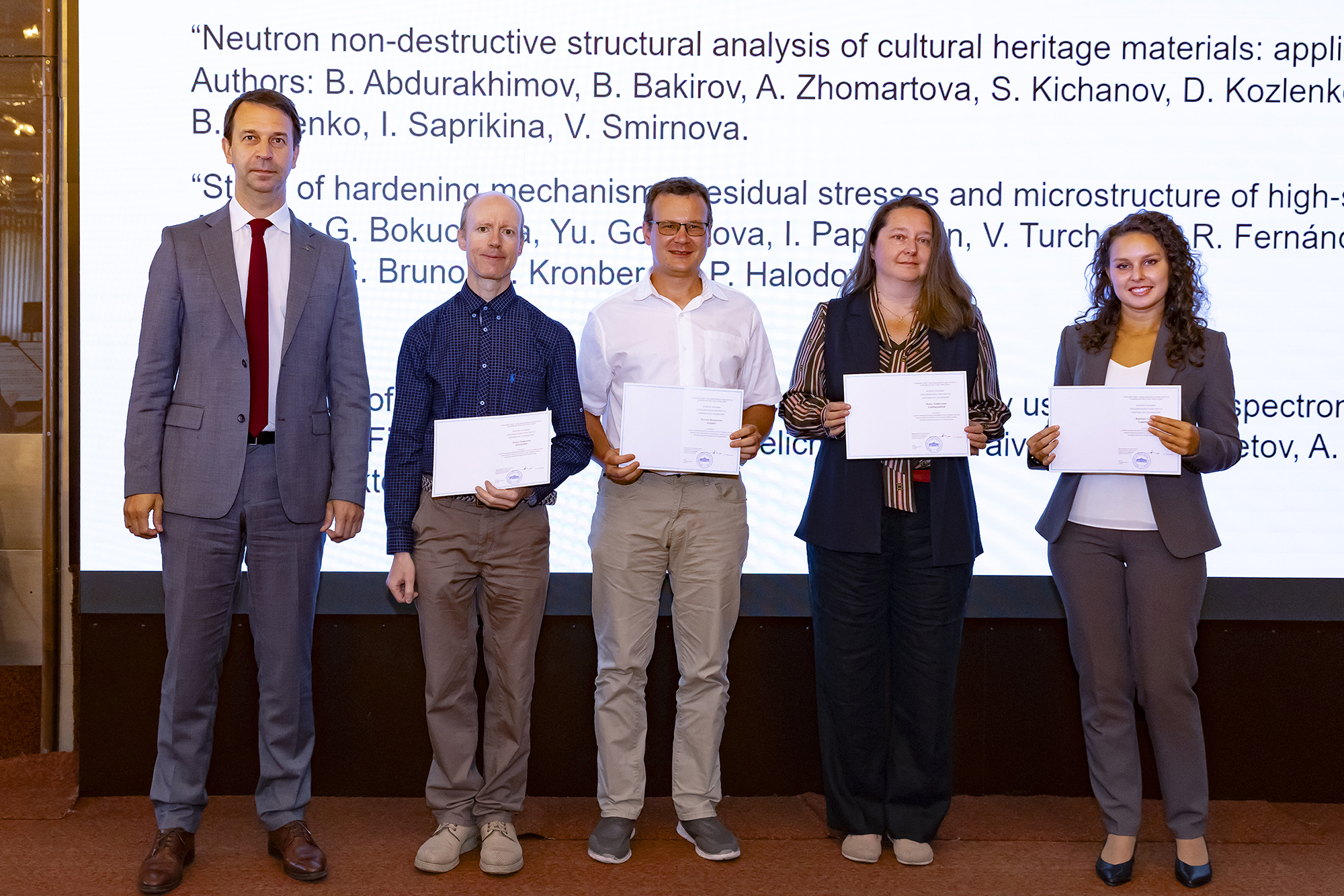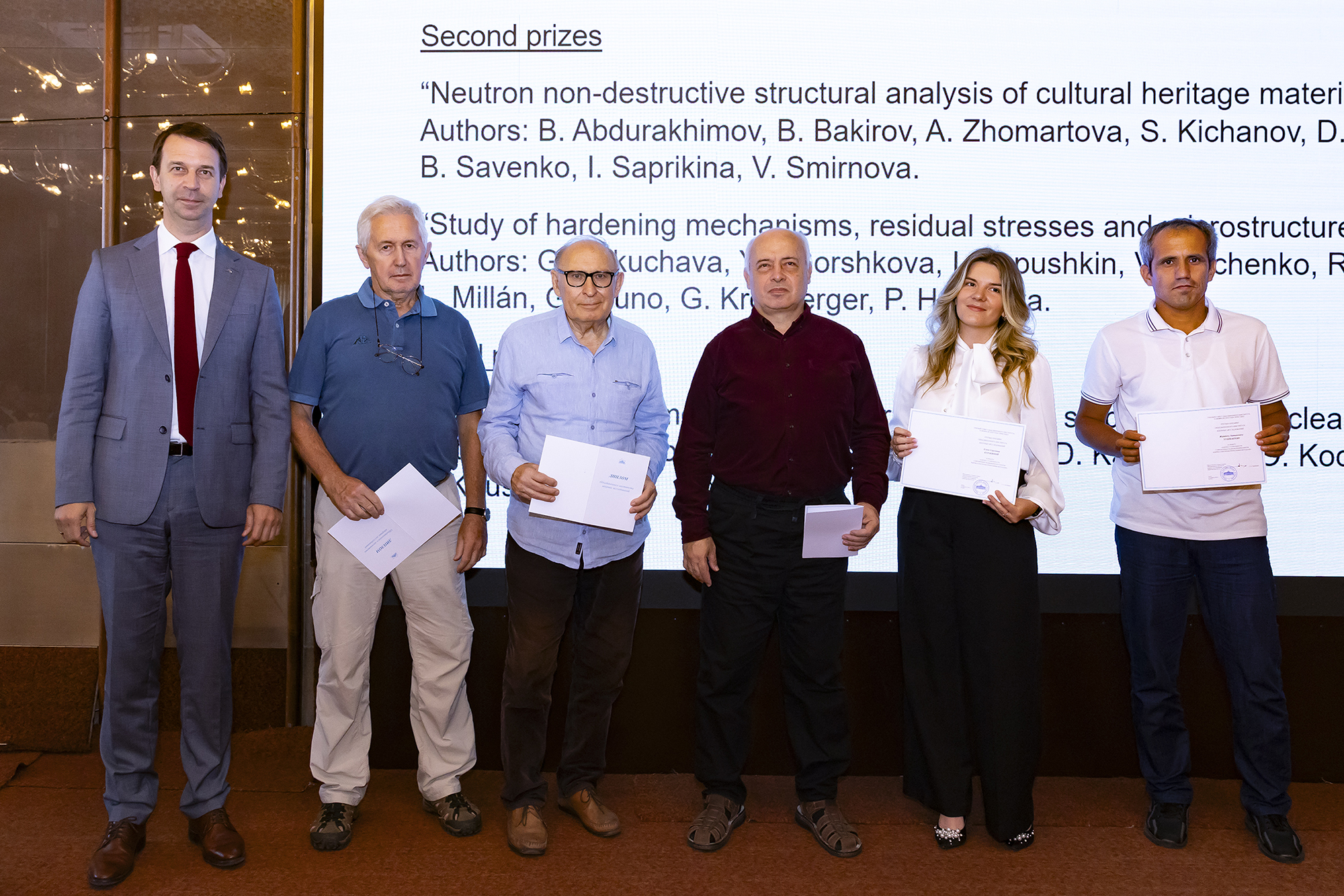Results of 136th session of JINR Scientific Council: reaching new frontiers
News, 16 September 2024
On 12–13 September, the 136th session of the Scientific Council of the Joint Institute for Nuclear Research took place in Dubna under the chairmanship of Academician of the National Academy of Sciences of Belarus, Professor Sergey Kilin. On the first day of the meeting, the session participants heard a report by the JINR Director on the results of scientific work and achievements of the Institute in 2024. The Council members reviewed the recommendations of the Programme Advisory Committees held in June. As part of the session, the Director of the Laboratory of Radiation Biology at JINR was elected. On the second day, the Scientific Council approved the decisions of the jury of the Bogoliubov, Dzhelepov, and Flerov JINR Prizes and announced the 2024 winners of the international OGANESSON Prize. The laureates of the 2023 JINR Prizes for the best research papers received diplomas.
The 136th session of the JINR Scientific Council started with a moment of silence in memory of the outstanding physicist, Honorary Doctor of the Joint Institute Bekhzod Yuldashev (09/05/1945 – 28/08/2024). Bekhzod Yuldashev contributed to the intensification of cooperation between scientists of Uzbekistan and JINR in the recent years and to the joint work of JINR and Uzbekistan universities in training highly qualified personnel for large scientific projects.
Director of the Joint Institute for Nuclear Research, Academician of the Russian Academy of Sciences (RAS) Grigory Trubnikov provided an overview on the key events in the JINR life in 2024. The report presented the decisions of the session of the Committee of Plenipotentiaries of the Governments of the JINR Member States, the progress of the implementation of the main projects of the 2024 Topical Plan, the results of the Institute’s work in strengthening international cooperation, and the results of JINR activities in training scientific personnel.
Members of the CP JINR session held in March 2024 in Dubna highlighted the effective work of the Institute on the development of international scientific cooperation with Member States and partner organizations and the success in carrying out the plan to improve the Institute’s research infrastructure.
In June 2024, Russian President Vladimir Putin visited the NICA Accelerator Complex at the Laboratory of High Energy Physics at JINR and initiated its technological run. This event marked the beginning of preparations for the physics run at NICA. As part of this visit, the President of Russia chaired a meeting of the Council for Science and Education in Dubna. “This was a historic event for Dubna and the Joint Institute for Nuclear Research. It demonstrated that the Russian Federation, the residence country and a Member State of the Institute, shows not only careful attention to the JINR scientific programme, but also readiness to support international scientific and technological cooperation,” Grigory Trubnikov commented.
JINR Director demonstrated the main performance indicators of the Institute in 2018-2024. The total number of results of intellectual activity of JINR scientists has increased significantly, along with the number of employees between the ages of 35 and 60, the category with the highest publication activity. The number of employees with academic degrees, Candidates and Doctors of Sciences, has returned to the pre-Covid level.
Speaking of the scientific activities of the Institute, Grigory Trubnikov highlighted the results of the Laboratory of Theoretical Physics at JINR in quantum field theory, inflationary cosmology, and physics of nuclear reactions and nuclear structure.
One of JINR’s flagship projects, the NICA Accelerator Complex, is actively developing. Elements of the magnetic cryostat system, power supplies, cryogenic and vacuum equipment, and energy evacuation systems are being installed. The cooling of the collider ring is scheduled for February–March 2025. In August, the researchers expect to detect the first Xe-beam collisions in the MPD (Multi-Purpose Detector) at NICA.
The MPD Collaboration is expanding. It currently includes more than 500 participants from 39 scientific centres in 12 countries. The MPD electromagnetic calorimeter modules, time-projection chamber, time-of-flight detector, and forward spectrometers have been manufactured and tested. They are now ready for installation in the detector solenoid. The superconducting solenoid was successfully cooled to the liquid nitrogen temperatures. Preparations are underway to cool it to the liquid helium temperatures. The detector is scheduled to be commissioned in July 2025.
The data from the BM@N (Baryonic Matter at Nuclotron) Experiment, obtained during the fourth commissioning run at NICA, is being analysed. Interesting results of physical analysis of data on the Λ-hyperon and K0-meson production and measurement of direct flow of protons in Xe+CsI collisions have been published. The next experiments will be conducted in 2025 as part of the commissioning run on the Booster-Nuclotron beam line. The BM@N Collaboration consists of 217 representatives of 13 institutions in 5 countries.
The Spin Physics Detector (SPD) Collaboration, which includes about 400 participants from 14 scientific organizations in 15 countries, is also gaining new members. Active discussions are underway regarding prospects for the collaboration to cooperate with other research centres in many countries of the world. Elements of the SPD are being engineered, including straw detectors, calorimeters, and data collection systems.
A meeting of the ARIADNA Collaboration (Applied Research Infrastructure for Advanced Developments at NICA fAcility), recently took place at JINR. The collaboration continues its fruitful activities. Currently, ARIADNA’s cooperating organizations are represented by 162 participants from 21 scientific centres in 15 countries. As part of this project, a programme of applied research in radiobiology and materials science will be implemented.
One of the key JINR projects is the Baikal-GVD Deep Underwater Neutrino Telescope. So far, 13 clusters consisting of 4,104 optical modules and 8 laser stations have been installed on Lake Baikal. The coastal infrastructure is developing. The events registered on the detector are being analysed, and the data is cross-checked with IceCube. The next expedition to build the Baikal Neutrino Telescope will start in February 2025. The project of the upgraded LINAC-200, a DLNP JINR main facility, was highlighted as one of the brightest achievements. The linear accelerator is ready for operation. It will be used for a wide range of fundamental and applied research using electron beams.
In May, the upgraded U-400M Facility was commissioned at the Laboratory of Nuclear Reactions at JINR: 16O, 40Ar, 132Xe ion beams were accelerated and transported. In the future, scientists plan to conduct an experiment to search for and study possible correlations of dineutrons and tetraneutrons in the 8He nucleus. The construction of the new experimental hall of the U-400R Accelerator continues. In the spring of 2024, researchers at the Suprheavy Element Factory successfully executed an experimental programme, irradiating 242Pu and 238U targets with 50Ti and 54Cr beams respectively. It resulted in 6 new events for the synthesis of livermorium. As the Director of the Institute noted, these reactions are an important stage in preparation for the synthesis of the new element 120.
The Laboratory of Neutron Physics at JINR is developing the BJN Project, the new inelastic neutron scattering spectrometer in inverse geometry. Manufacturing of the spectrometer elements will start in 2025, and the installation is set to be commissioned in 2028. Speaking of other areas of FLNP research, the Director highlighted battery development studies and experiments on air pollution biomonitoring in the Republic of Kazakhstan and the Republic of Serbia using mosses. At the end of this April, JINR received a license from the Federal Service for Environmental, Technological, and Nuclear Supervision of Russia (Rostekhnadzor) to operate the IBR-2 Fast-Neutron Pulsed Reactor up to April 2032. The reactor’s user program is to resume in the spring of 2025.
The Laboratory of Information Technologies at JINR is developing the Multifunctional Information and Computing Complex (MICC). The Govorun Supercomputer is progressively increasing its capacity every six months. At the moment, the total peak performance of the computer is 1.7 petaflops in double-precision computations. In his report, the JINR Director noted new services based on the HybriLIT Platform and their implementation in research into quantum computing and bioinformatics.
LRB JINR scientists have improved the capabilities of the DNA Simulation Toolkit software package based on Geant4 and designed for radiobiological modelling at the cellular level. In addition, the Laboratory studied the effects of neutron and proton beam radiation exposure on the breast cancer stem cells in vitro. As a result, the researchers proved combined irradiation to be significantly more effective than traditional methods.
In his speech, Grigory Trubnikov congratulated colleagues from the European Organization for Nuclear Research (CERN) on their 70th anniversary, emphasising the extensive JINR participation in the organization’s projects since 1957. Scientists at the Joint Institute continue to contribute to the development of the Large Hadron Collider (LHC) by working in the CMS, ATLAS, and ALICE Experiments. Other CERN collaborations that JINR took active part in are COMPASS, NA48, NA49, NA62, and OPERA along with the NA61 and NA64 Collaborations it is still a part of. Within the CMS Project, the Joint Institute initiated the RDMS (Russia and JINR Member States) Collaboration, which made it possible to effectively coordinate the work of these countries and make their contribution more visible. In addition, JINR participated in CERN’s software development projects (NICE, LabVIEW, EDH) and the EGEE Project. In June, the CERN Council made a decision to extend the cooperation agreement with the Joint Institute and continue working together.
In addition, JINR is successfully fulfilling its obligations as part of the COMET (COherent Muon to Electron Transition) projects of the Japanese Proton Accelerator Research Complex (J-PARC) and T2K.
The JINR University Centre holds annual schools for students and teachers, internships for schoolchildren, and the START and INTEREST Programmes for students, conducts popular science lectures, and arranges visits of schoolchildren and students to the JINR laboratories.
International scientific and technical cooperation is one of the most important areas of activity of the Joint Institute. Scientific ties with Chinese research centres are strengthening as part of the agreement between JINR and the Ministry of Science and Technology of the People’s Republic of China. In July, Dubna hosted the 6th meeting of the BRICS Working Group on Research Infrastructures and Megascience Projects, which brought together representatives of all the member states of the organization. Fruitful cooperation is developing between the Institute’s Member States.
Heads of the JINR Programme Advisory Committees Itzhak Tserruya, Valery Nesvizhevsky, and Dénes Lajos Nagy informed the Scientific Council about the recommendations adopted at the PAC meetings for Particle Physics, Nuclear Physics, and Condensed Matter Physics in June 2024.
The JINR Scientific Council took note of the successful completion of the first stage of the NICA Megascience Project and the continuing growth and development of the MPD, BM@N, and SPD Collaborations. Chair of the PAC for Particle Physics Itzhak Tserruya said that the KRION-6T Heavy Ion Source and the HILAC Linear Accelerator of the Collider’s Injection Complex, Booster, Nuclotron, and beam transfer channels have now been commissioned. The fundamental and applied research programme at the fixed-target facilities has been initiated. The JINR SC approved the PAC PP recommendation on the extension of the Nuclotron-NICA Project until the end of 2027.
The members of the JINR Scientific Council also thanked the PAC for Particle Physics for the support that the Committee provides to the leadership of the Institute in establishing close cooperation of scientists and specialists from the JINR Member States with CERN. The contribution of JINR researchers participating in major international experiments at the LHC to the physical data analysis and the modernisation of facilities’ detectors was highly appreciated.
SC supported the PAC PP recommendation on the implementation of a new project to develop a particle registration technique in future JINR experiments aimed at R&D for new detectors and novel methods for processing and analysing experimental data.
The Scientific Council approved the recommendations of the PAC on Nuclear Physics on the planned projects of FLNR, DLNP, and LRB at JINR. In his speech Chair of the Committee Valery Nesvizhevsky noted significant results during the analysis of the first experiments carried out at the ACCULINNA-2 Separator before the modernisation of the U-400M Accelerator Complex. The Scientific Council recognised the relevance and importance of devising new detector systems designed to study rare events in low energy physics. Radiochemical studies carried out at the Laboratory for Nuclear Problems at JINR were also highly appreciated. The SC highlighted the significant contribution of these studies to nuclear medicine, spectrometry, and astrophysics.
The Scientific Council supported the recommendation of the PAC for Condensed Matter Physics to continue work on the project of a new neutron source and stressed its importance for future JINR research. The proposal by the PAC CMP Chair Dénes Lajos Nagy to initiate a new FLNR JINR project for the development of highly sensitive sensors based on molecular recognition for virus detection was approved. SC JINR welcomed the intention of the Directorate of the Laboratory of Neutron Physics to resume operation and the user program of the IBR-2 Research Pulse Reactor in 2024-2025.
At the 136th SC session, new members of the JINR Programme Advisory Committees were approved. Professor at the Indian Institute of Technology Madras (IIT Madras) Ravi Kumar became the PAC member for Condensed Matter Physics. Three scientists have become new members of the PAC for Particle Physics:
- Leandar Litov — Sofia University “St. Kliment Ohridski”, Bulgaria;
- Gobinda Majumder — Tata Institute of Fundamental Research (TIFR), Mumbai, India;
- Amaresh Jaiswal — National Institute of Science Education and Research NISER, Bhubaneswar, India.
Professor at the Indian Institute of Technology Indore (IIT Indore), Leader of the ALICE-START-INDIA Collaboration Raghunath Sahoo made a report about the study of quark-gluon plasma at the Large Hadron Collider. Professor Sahoo underlined the active participation of the Indian scientific community in major international projects. 70 employees from 12 Indian research centres are currently working on the ALICE Experiment at the LHC at CERN.
At the end of the first day, elections were held for the position of Director of the Laboratory of Radiation Biology at JINR. Alexander Bugay, Doctor of Physics and Mathematics, who has held the position since 2019, was re-elected as LRB JINR Director for the next 5-year term. According to the decision of the Scientific Council, candidates for the positions of the LRB deputy directors will be approved at the next, 137th session.
On 13 September, young scientists presented their reports recommended at the meetings of the JINR Programme Advisory Committees to the members of the Scientific Council. Ksenia Alishina (VBLHEP) delivered a report on the study of the Λ-hyperon production in carbon collisions with solid targets in the BM@N Experiment. The report entitled “Real-time follow-up of multimessenger alerts at the Baikal-GVD Telescope” was presented by Viktoriya Dik (DLNP). Olga Lis (FLNP) reported about the pressure effect on crystal, magnetic structure and vibrational properties of van der Waals materials.
At the meeting, Grigory Trubnikov announced the winners of the international OGANESSON Prize for 2024. The award is presented annually for significant achievements in theoretical and experimental research in physics, chemistry, biology, and applied problems, as well as for creative endeavours that popularise science by means of educational and scientific activities. This year’s laureates:
- Researcher at Nazarbayev University (Republic of Kazakhstan), Candidate of Physics and Mathematics Aliya Nurmukhanbetova — for the development and implementation of a new programme for the study of light nuclei at the DC-60 Low-Energy Ion Accelerator;
- Senior Researcher at the Laboratory of Nuclear Reactions at JINR, Candidate of Physics and Mathematics Galina Knyazheva — for pioneering work on the observation and study of the quasi-fission process of the heavy nuclei;
- Academician of the Russian Academy of Sciences Yuri Zolotov — for outstanding scientific work in analytical chemistry and significant personal contribution to the training of young scientists, specialists, and highly qualified personnel;
- Vice-Chancellor and Principal of the University of the Witwatersrand (South Africa) Zeblon Vilakazi — for significant personal contribution to the development of scientific cooperation between South Africa and JINR in nuclear reactions, accelerator technologies, and high energy physics;
- Director of the the Institute of Cognitive Studies at Saint Petersburg University, Honoured Worker of Higher Education, and Honoured Scientist of the Russian Federation Tatiana Chernigovskaya — for outstanding contribution to the popularisation of scientific knowledge and the development of interdisciplinary research at the intersection of neuroscience, linguistics, and psychology.
On the same day, the winners of three international awards named after outstanding scientists — founders of JINR — were announced. Advisor to the Directorate of the Laboratory of Nuclear Problems Nikolai Russakovich made a report on the awarding of the Venedikt Dzhelepov Prize in 2024. Advisor to the Directorate of the Laboratory of Neutron Physics at JINR Marina Frontasyeva became the laureate this year for her great contribution to the development of the international programme for air quality assessment using neutron activation analysis.
FLNR JINR Scientific Leader, RAS Academician Yuri Oganessian presented the winners of the Georgy Flerov Prize awarded at the RAS Council on Heavy Ion Physics in May 2024. The winners are Radiy I. Ilkaev, co-author of the discovery of element 114 (flerovium), Evgeny D. Donets, co-author of the discovery of elements 102 (nobelium) and 103 (lawrencium), Evgeny E. Donets, Head of the Electron Beam Ion Source Sector at VBLHEP at JINR, Zhao Hongwei, Deputy Director at the Institute of Modern Physics of the Chinese Academy of Sciences (Lanzhou).
This year marks the 115th anniversary of the birth of an outstanding scientist, JINR Director for many years, Nikolai N. Bogoliubov. As part of the 136th session of the Scientific Council, the presentation ceremony of the Nikolai Bogoliubov International Prize took place. Scientific Leader of the Joint Institute for Nuclear Research Victor Matveev presented the laureates. For outstanding achievements in theoretical and mathematical physics as well as contribution to the strengthening of international cooperation, the Prize was awarded to Academician of the Bulgarian Academy of Sciences Ivan Todorov and Professor of the Institute of Theoretical Physics in Madrid (IFT UAM-CSIC) Alvaro de Rújula, who attended the meeting.
The Spanish specialist addressed the members of the Scientific Council, sharing the most significant, in his opinion, milestones in the development of physics. Professor de Rújula recalled that back in the second half of the 20th century, many scientists doubted the possibility of detecting the Higgs boson. He also spoke about the discovery of the colour of quarks that took place at the Joint Institute for Nuclear Research. Speaking about his experience of working with Soviet scientists, Professor de Rújula noted their great commitment to science.
“I remember Professor Bogoliubov being a very kind and nice person when I met him,” Alvaro de Rújula highlighted. “It is a great honour for me, probably the greatest I have ever had. I am very glad and moved, the Prize gave me the occasion to see many of my old friends who work here. It was a great pleasure in every respect.”
In conclusion of the meeting’s open part, Grigory Trubnikov and Chief Scientific Secretary of the Institute Sergey Nedelko presented diplomas to the winners of the 2023 JINR Prizes. The awards were given for the best scientific, scientific and methodological, and scientific and technical applied works.
The meeting concluded with the adoption of the SC Resolution. The next, 137th session of the Scientific Council of the Joint Institute for Nuclear Research will take place in February 2025.

